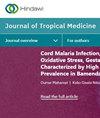Breeding Habitat Preference of the Dengue Vector Mosquitoes Aedes aegypti and Aedes albopictus from Urban, Semiurban, and Rural Areas in Kurunegala District, Sri Lanka
IF 2.5
4区 医学
Q3 PUBLIC, ENVIRONMENTAL & OCCUPATIONAL HEALTH
引用次数: 0
Abstract
Elimination of vector mosquito larvae and their breeding environments is an effective strategy in dengue disease control. Present study examined larval density and water quality in breeding habitats and container preference of dengue vectors Ae. aegypti and Ae. albopictus. Larval surveys were conducted monthly in urban, semiurban, and rural sites in Kurunegala, Sri Lanka, from January 2019 to December 2021. Larval densities were recorded under the following three categories: type of container (16 types), type of material (6 types), and location (indoor/outdoor). Breeding preference ratios (BPRs) were calculated using Index of Available Containers and the Index of Contribution to Breeding Sites. Out of 19,234 wet containers examined, larval stages were found in 1,043 habitats. Ae. albopictus larvae were in all three areas whereas Ae. aegypti larvae were restricted to urban areas. Highest number of wet containers and highest positivity were reported from urban followed by semiurban. In general, discarded nondegradable items were the most frequent and mostly positive breeding sites. For Ae. aegypti, the most preferred breeding sites were gutters and concrete slabs. Ae. albopictus mostly preferred concrete slabs in urban areas and tyres in semiurban and rural areas. Material types such as rubber and concrete were mostly preferred by Ae. aegypti whereas ceramic was preferred by Ae. albopictus. Although plastic was the most available material type in all study sites, preference to plastic was low except for urban Ae. albopictus. Both species preferred urban indoor breeding habitats although outdoor breeding was preferred by Ae. albopictus in rural areas. Larval densities of Ae. aegypti and semiurban Ae. albopictus significantly correlated with the BPR of the container type and material type. Dengue vector larvae were found in a 6.7–9.4 pH range. Total dissolved solids and alkalinity positively correlated with preference. Information generated can be successfully used in waste management and public education for effective vector control.斯里兰卡库鲁内加拉地区城市、半城市和农村地区登革热病媒蚊子埃及伊蚊和白纹伊蚊的繁殖生境偏好
消灭病媒蚊幼虫及其繁殖环境是控制登革热病的有效策略。本研究调查了登革热病媒埃及伊蚊和白纹伊蚊的幼虫密度、繁殖栖息地的水质以及对容器的偏好。从2019年1月至2021年12月,每月在斯里兰卡库鲁内加拉的城市、半城市和农村地区进行幼虫调查。幼虫密度记录分为以下三类:容器类型(16 种)、材料类型(6 种)和地点(室内/室外)。利用可用容器指数和繁殖地贡献指数计算繁殖偏好比率(BPRs)。在检查的 19,234 个湿容器中,在 1,043 个生境中发现了幼虫阶段。白纹伊蚊幼虫出现在所有三个地区,而埃及伊蚊幼虫则局限于城市地区。城市地区的湿容器数量最多,阳性率最高,其次是半城市地区。一般来说,不可降解的废弃物品是最常见的阳性繁殖地。埃及蚁最喜欢的繁殖地是排水沟和水泥板。白纹伊蚊在城市地区最喜欢水泥板,在半城市和农村地区则喜欢轮胎。埃及蚁主要喜欢橡胶和混凝土等材料类型,而白纹伊蚊则喜欢陶瓷。虽然塑料是所有研究地点中最容易获得的材料类型,但除了城市白纹伊蚊外,其他物种对塑料的偏好度都很低。两种白纹伊蚊都喜欢在城市室内繁殖,但农村地区的白纹伊蚊更喜欢在室外繁殖。埃及登革热蚁和半城市白纹伊蚊的幼虫密度与容器类型和材料类型的 BPR 显著相关。登革热病媒幼虫的 pH 值范围为 6.7-9.4。总溶解固体和碱度与偏好呈正相关。所生成的信息可成功用于废物管理和公众教育,以有效控制病媒。
本文章由计算机程序翻译,如有差异,请以英文原文为准。
求助全文
约1分钟内获得全文
求助全文
来源期刊

Journal of Tropical Medicine
Immunology and Microbiology-Parasitology
CiteScore
3.90
自引率
4.50%
发文量
0
审稿时长
14 weeks
期刊介绍:
Journal of Tropical Medicine is a peer-reviewed, Open Access journal that publishes original research articles, review articles, and clinical studies on all aspects of tropical diseases. Articles on the pathology, diagnosis, and treatment of tropical diseases, parasites and their hosts, epidemiology, and public health issues will be considered. Journal of Tropical Medicine aims to facilitate the communication of advances addressing global health and mortality relating to tropical diseases.
 求助内容:
求助内容: 应助结果提醒方式:
应助结果提醒方式:


